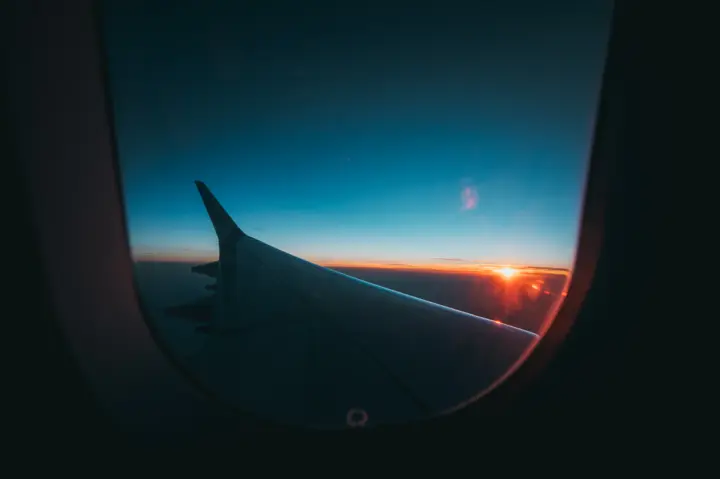Flying can negatively affect your skin
When you travel by plane, you collect passports, tickets, clothing, and medical supplies, trying to anticipate your needs. But one aspect of air travel is often overlooked: its effect on your skin. Aviation is not good for the dermis. Whether you're a frequent traveler or taking a long-awaited vacation, understanding how air travel can negatively affect your skin is the first step to getting under control. Flying can increase the risk of skin cancer, dry skin, acne outbreaks, dullness and swelling but with knowledge, you can take steps to mitigate these effects and ensure your skin is in the best possible condition.
Show key points
- Air travel exposes passengers to heightened levels of ultraviolet radiation due to high altitudes, significantly increasing the risk of skin cancer, especially for those seated by windows.
- Aircraft cabins have extremely low humidity, often below 20%, which can severely dehydrate your skin and cause dryness, flakiness, and discomfort.
- The drop in cabin humidity and altered skincare routines can trigger excess oil production and acne breakouts, particularly on the forehead, nose, and chin.
- ADVERTISEMENT
- Increased cabin pressure and high sodium intake during flights can lead to facial and leg swelling due to fluid retention and slower lymphatic drainage.
- Long-haul flights may cause your skin to appear dull and fatigued, driven by reduced oxygen saturation and nutrient flow in the blood at high altitudes.
- Protective strategies such as applying broad-spectrum sunscreen, using hyaluronic acid-based moisturizers, and staying hydrated help mitigate air travel’s effects on skin.
- Movement during flights, proper posture, and practices like facial massages can help maintain circulation and combat fluid buildup effectively.
Skin cancer

The amount of sun exposure affects not only the risk of skin cancer, but also its severity, which is why dermatologists recommend avoiding outdoor activity between 10 a.m. and 2 p.m. At typical flight altitudes (about 30,000 feet), ultraviolet radiation is almost twice as powerful as those on Earth. If you sit by the window, the risk of skin cancer and sun-related damage increases. Research published in the journal JAMA Dermatology revealed that cabin crew and pilots had twice the incidence of melanoma, a type of skin cancer, compared to the general population. The researchers also found that crew were more likely to develop non-melanoma skin cancer as well. DNA damage comes primarily from two types of ultraviolet radiation: UVA and UVB. Exposure to UVA and UVB rays over time increases the risk of skin cancer. In addition, short ultraviolet (UVB) rays are responsible for sunburn, and longer ultraviolet (UVA) rays, which penetrate deeper into the skin, causing wrinkles, loss of elasticity, and age spots. The windows of the aircraft do not completely block ultraviolet radiation. Although the polycarbonate layers embedded in the windows filter out a large amount of UV light (though not all), UV rays penetrate significantly. Although window seats are most exposed to UV rays, any cabin seat is at risk. Although most of us don't travel by plane like cabin crews or pilots, some do, and we should all avoid unnecessary sun exposure regardless of our profession. Before boarding any flight, apply a sunscreen that offers broad UVA and B protection with an SPF of at least 30 to exposed skin. Consider wearing a long-sleeved jacket or jacket, and if you're sitting by the window, close the window cover after takeoff.
Recommend
Dehydration

Skin is most comfortable when moisture is between 40 and 70%. However, the humidity in an aircraft cabin is usually less than 20%, less than half of what you're used to. When moisture drops, your skin is less hydrated, resulting in dry, flaky and red skin that may feel tight. Dried skin may also look wrinkled and less radiant. Counteract the impact of dryness by enhancing your hydration routine. Apply a moisturizing mask containing hyaluronic acid in the evening before or in the morning of your trip. Hyaluronic acid is a sugar molecule that occurs naturally in the skin and has a tendency to water and binds to it. In addition, apply a moisturizer over your entire skin, which, along with locking in moisture, will provide a barrier against irritants found in recycled aircraft and crowded airport air. Reapply the humidifier when disembarking from the plane. Try to minimize alcohol and caffeine because they cause dehydration, and drink plenty of fluids while you're in the air.
Acne

The skin sometimes increases sebum production to compensate for dry cabin air. This can lead to temporary oily skin, leading to acne. In addition, changes in skincare procedures, poor air quality, lack of sleep, and increased sugar and salt in airline foods can contribute to the appearance of acne. The forehead, chin and nose are the most vulnerable areas. It may help to apply a non-pore clogging water moisturizer on your face before your trip
Fluid retention

Cabin pressure at flight altitude is equivalent to 6,000 to 8,000 feet above sea level which can slow lymphatic drainage and contribute to leg and face swelling. Snacks and salty meals increase this because excess sodium contributes to fluid retention, and after several hours, your face may be noticeably swollen. Consider preparing your own snacks. To counter fluid retention, move. Walk the lanes, however brief, when possible. Any increase in activity will activate the lymphatic vessels, improve blood circulation, and hopefully prevent fluid accumulation. Keep your head high, especially when sleeping on an airplane. Consider gentle facial massages or facial expression exercises that may induce drainage.
Dullness

Long flights can lead to dull and tired skin. The dull appearance is primarily due to two factors. First, the higher the rise, the lower the oxygen saturation in the blood. For example, according to one study, a group of passengers had blood oxygen saturation levels of 97 percent at the airport, which dropped to 93 percent when the flight was elevated. This means that lower levels of renewable oxygen are available to reach the tissues. Second, an increase in pressure can lead to reduced blood flow, which also contributes to reduced oxygen as well as nutrient and antioxidant delivery.








